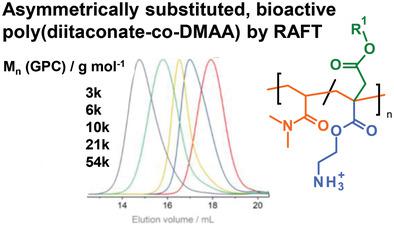当前位置:
X-MOL 学术
›
Macromol. Chem. Phys.
›
论文详情
Our official English website, www.x-mol.net, welcomes your
feedback! (Note: you will need to create a separate account there.)
Asymmetrically Substituted Poly(diitaconates) Obtained by Reversible Addition‐Fragmentation Chain Transfer (RAFT) Polymerization: Synthesis, Copolymerization Parameters, and Antimicrobial Activity
Macromolecular Chemistry and Physics ( IF 2.5 ) Pub Date : 2019-11-27 , DOI: 10.1002/macp.201900346 Andreas Himmelsbach 1 , Alexandra Schneider‐Chaabane 1 , Karen Lienkamp 1
Macromolecular Chemistry and Physics ( IF 2.5 ) Pub Date : 2019-11-27 , DOI: 10.1002/macp.201900346 Andreas Himmelsbach 1 , Alexandra Schneider‐Chaabane 1 , Karen Lienkamp 1
Affiliation

|
Asymmetrically substituted poly(diitaconate) copolymers are synthesized from 1‐((N‐tert‐butoxycarbonyl)‐2‐aminoethyl)‐4‐propyl diitaconate (PrIA) and different comonomers (N,N‐dimethyl‐acrylamide, DMAA; acrylic acid; or ((N‐tert‐butoxycarbonyl)‐2‐aminoethyl)methacrylate) by reversible addition–fragmentation chain transfer polymerization (RAFT). The RAFT copolymerization parameters of PrIA and DMAA are rDMAA = 0.49 and rPrIA = 0.17, compared to rDMAA = 0.52 and rPrIA = 0.54 obtained by free radical copolymerization (FRP). Thus, the RAFT process has a stronger trend to alternating polymerization than the FRP process. The polydispersity index of the RAFT copolymers is around 1.2–1.8, compared to 2.8–2.9 for the corresponding FRP copolymers. After removal of the tert‐butoxycarbonyl protective groups, antimicrobially active synthetic mimics of antimicrobial peptides are obtained. The thus activated poly(PrIA‐co‐DMAA) copolymers (repeat unit ratio 1:1) have an increasing activity against Escherichia coli and Staphylococcus aureus with increasing molar mass. The RAFT copolymers are slightly more active and less toxic than comparable FRP polymers, leading to a higher selectivity for bacteria over mammalian cells. Higher molar fractions of PrIA in poly(PrIA‐co‐DMAA) copolymers (up to 80 mol%) do not increase their antimicrobial activity; reduction of the BuIA content in poly(BuIA‐DMAA) (down to 10 mol%) leads to a loss of activity against both E. coli and S. aureus.
中文翻译:

通过可逆加成-断裂链转移(RAFT)聚合获得的不对称取代的聚二钛酸酯:合成,共聚参数和抗菌活性
不对称取代的聚(二衣康酸酯)共聚物是由1中合成- ((ñ -叔丁氧羰基)-2-氨基乙基)-4-丙基二衣康酸酯(PRIA)和不同的共聚单体(N,N-二甲基丙烯酰胺,DMAA;丙烯酸;或((ñ -叔丁氧基羰基)-2-氨基乙基)甲基丙烯酸酯)的可逆加成-断裂链转移聚合(RAFT)。PrIA和DMAA的RAFT共聚参数为r DMAA = 0.49和r PrIA = 0.17,而r DMAA = 0.52和r PrIA通过自由基共聚(FRP)获得的= 0.54。因此,RAFT工艺比FRP工艺具有更强的交替聚合趋势。RAFT共聚物的多分散指数约为1.2-1.8,而相应的FRP共聚物的多分散指数为2.8-2.9。除去叔丁氧羰基保护基后,可获得抗菌肽的抗菌活性合成模拟物。如此活化的聚(PrIA- co- DMAA)共聚物(重复单元比例为1:1)对大肠杆菌和金黄色葡萄球菌的活性增强随着摩尔质量的增加。与可比的FRP聚合物相比,RAFT共聚物的活性稍高,毒性也较小,从而导致细菌对哺乳动物细胞的选择性更高。聚(PrIA- co- DMAA)共聚物中较高的PrIA摩尔分数(最高80 mol%)不会增加其抗菌活性;降低聚(BuIA-DMAA)中的BuIA含量(低至10 mol%)会导致针对大肠杆菌和金黄色葡萄球菌的活性降低。
更新日期:2019-11-27
中文翻译:

通过可逆加成-断裂链转移(RAFT)聚合获得的不对称取代的聚二钛酸酯:合成,共聚参数和抗菌活性
不对称取代的聚(二衣康酸酯)共聚物是由1中合成- ((ñ -叔丁氧羰基)-2-氨基乙基)-4-丙基二衣康酸酯(PRIA)和不同的共聚单体(N,N-二甲基丙烯酰胺,DMAA;丙烯酸;或((ñ -叔丁氧基羰基)-2-氨基乙基)甲基丙烯酸酯)的可逆加成-断裂链转移聚合(RAFT)。PrIA和DMAA的RAFT共聚参数为r DMAA = 0.49和r PrIA = 0.17,而r DMAA = 0.52和r PrIA通过自由基共聚(FRP)获得的= 0.54。因此,RAFT工艺比FRP工艺具有更强的交替聚合趋势。RAFT共聚物的多分散指数约为1.2-1.8,而相应的FRP共聚物的多分散指数为2.8-2.9。除去叔丁氧羰基保护基后,可获得抗菌肽的抗菌活性合成模拟物。如此活化的聚(PrIA- co- DMAA)共聚物(重复单元比例为1:1)对大肠杆菌和金黄色葡萄球菌的活性增强随着摩尔质量的增加。与可比的FRP聚合物相比,RAFT共聚物的活性稍高,毒性也较小,从而导致细菌对哺乳动物细胞的选择性更高。聚(PrIA- co- DMAA)共聚物中较高的PrIA摩尔分数(最高80 mol%)不会增加其抗菌活性;降低聚(BuIA-DMAA)中的BuIA含量(低至10 mol%)会导致针对大肠杆菌和金黄色葡萄球菌的活性降低。











































 京公网安备 11010802027423号
京公网安备 11010802027423号